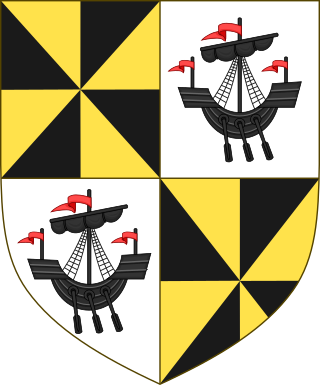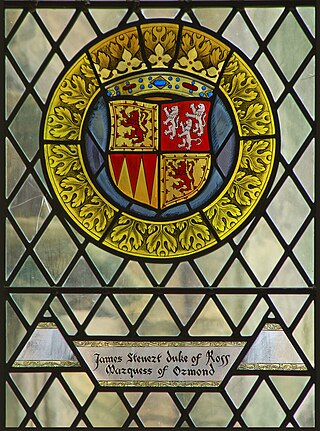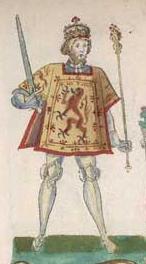Related Research Articles

James IV was King of Scotland from 11 June 1488 until his death at the Battle of Flodden in 1513. He inherited the throne at the age of fifteen on the death of his father, James III, at the Battle of Sauchieburn, following a rebellion in which the younger James was the figurehead of the rebels. James IV is generally regarded as the most successful of the Stewart monarchs. He was responsible for a major expansion of the Scottish royal navy, which included the founding of two royal dockyards and the acquisition or construction of 38 ships, including the Michael, the largest warship of its time.

James III was King of Scots from 1460 until his death at the Battle of Sauchieburn in 1488. He inherited the throne as a child following the death of his father, King James II, at the siege of Roxburgh Castle. James III's reign began with a minority that lasted almost a decade, during which Scotland was governed by a series of regents and factions who struggled for possession of the young king before his personal rule began in 1469.

Gillespie Archibald Campbell, 2nd Earl of Argyll was a Scottish nobleman and politician who was killed at the Battle of Flodden.

Archibald Douglas, 5th Earl of Angus was a Scottish nobleman, peer, politician, and magnate. Tradition has accorded him the nickname Archibald 'Bell-the-Cat' due to his association with the 1482 rebellion against James III of Scotland. He became one of the most powerful nobleman in Scotland through his influential position on the Scottish Marches, and a willingness to be involved in multiple rebellions in the reigns of James III and James IV of Scotland.
The Battle of Sauchieburn was fought on 11 June 1488, at the side of Sauchie Burn, a stream about two miles (3 km) south of Stirling, Scotland. The battle was fought between the followers of King James III of Scotland and a large group of rebellious Scottish nobles including the future Alexander Home, 2nd Lord Home, who were nominally led by the king's 15-year-old son, James, Duke of Rothesay. James III was killed in the battle, and his son succeeded him as James IV.

James Stewart, Duke of Ross was a Scottish prince, and the second son of King James III of Scotland and his wife, Margaret of Denmark. James was heir presumptive to his brother until his death, and was Archbishop of St Andrews and Lord Chancellor of Scotland.

Thomas Cochrane, also referred to as "Robert Cochrane" in sixteenth-century chronicle accounts, was a royal servant and alleged "familiar" or favourite of King James III of Scotland. Chronicle accounts allege that his influence over the king incurred the wrath of the old aristocracy, culminating in a coup at Lauder in which James III was arrested and Cochrane was executed.
James Kennedy was a 15th-century Bishop of Dunkeld and Bishop of St. Andrews, who participated in the Council of Florence and was the last man to govern the diocese of St. Andrews purely as bishop. One of the Gaelic clan of Carrick he became an important figure in the government of the minority of King James III of Scotland as well as founder of St Salvator's College, St Andrews.
William Scheves was the second Archbishop of St. Andrews. His parentage is obscure, but he was probably the illegitimate son of a royal clerk, John Scheves. Sixteenth-century accounts claim he spent several years abroad and studied at the University of Louvain. He spent several years at the University of St Andrews as an administrator. In his earlier ecclesiastical career, he had been clericus regiae and master of the hospital of Brechin. In 1474 he was provided unsuccessfully to the Archdeaconry of Dunblane, but by the beginning of 1477 he was Archdeacon of St Andrews and coadjutor (successor) and vicar-general of the archdiocese. After the deposition of Archbishop Patrick Graham in 1478, he succeeded to the archbishopric, apparently receiving the papal pall while in the presence of King James III and many of the nobility at Holyrood.

The Treaty of Westminster was signed on 13 February 1462 between Edward IV of England of the House of York and the Scottish John of Islay, Earl of Ross, Lord of the Isles. The agreement proposed that if Scotland was conquered by England, the lands north of the Scottish sea would be divided between the Lord of the Isles and the Earl of Douglas to be held from the crown of England, while the Earl of Douglas would hold Scotland south of the Firth.

Clan Lindsay is a Scottish clan of the Scottish Lowlands.
Holders of the office of Lord Chamberlain of Scotland are known from about 1124. It was ranked by King Malcolm as the third great Officer of State, called Camerarius Domini Regis, and had a salary of £200 per annum allotted to him. He anciently collected the revenues of the Crown, at least before Scotland had a Treasurer, of which office there is no vestige until the restoration of King James I when he disbursed the money necessary for the maintenance of the King's Household.

David de Lindsay, Lord of Barnweill and Byres, was a Scottish knight and crusader. A minor baronial lord, he was the son of David de Lindsay and held lands in East Lothian and South Ayrshire. He became Justiciar of Lothian under Alexander II of Scotland in 1241. This position had been held by his father earlier in the century.
In July 1482 an English army invaded Scotland during the Anglo-Scottish Wars. The town of Berwick-upon-Tweed and its castle were captured and the English army briefly occupied Edinburgh. These events followed the signing of the Treaty of Fotheringhay, 11 June 1482, in which Alexander Stewart, Duke of Albany, the brother of James III of Scotland declared himself King of Scotland and swore loyalty to Edward IV of England. The follow-up invasion of Scotland under the command of Edward's brother, Richard, Duke of Gloucester failed to install Albany on the throne, but Berwick has remained English ever since the castle surrendered on 24 August. The English army left Edinburgh with a promise for the repayment of the dowry paid for the marriage of Princess Cecily of England to the Scottish Prince.
Adam Abell was a Scottish friar at Jedburgh Abbey. He wrote a chronicle in the 1530s that gives an insight into contemporary thought and contains anecdotes that appear in later writings. The manuscript of the Roit or Quheil of Tyme is kept at the National Library of Scotland, Ms. 1746. It was donated by Lt.-Colonel W. W. Cunninghame of Caprington.
William Ruthven, 1st Lord Ruthven was a Scottish nobleman and founder of the noble lines of the Ruthven family.

The Treaty of York (1464) was made between England and Scotland on 1 June 1464 at York and was intended to establish 15 years of peace. Previously Scotland had supported the defeated House of Lancaster in the English civil War of the Roses.
Patrick Lindsay, 4th Lord Lindsay of the Byres was a reputed advisor of James IV of Scotland, and counsellor to Margaret Tudor.
Patrick Lindsay, 6th Lord Lindsay of the Byres, (1521–1589), Scottish courtier and Confederate lord.

Sir James (de) Lindsay, 9th Lord of Crawford, Knight Banneret, Lord of Crawford, Kirkmichael, Wigton, Symontoun, and of many other baronies, claiming also to be Lord of Buchan, was a Scottish feudal lord.
References
- ↑ Macdougall, Norman, James III, John Donald (1982), p.254, 256, 261-263